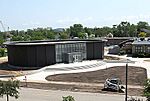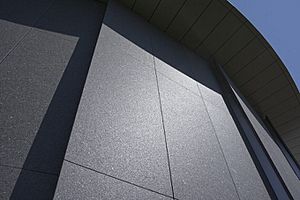Kruizenga Art Museum facts for kids

Site of the Kruizenga Art Museum, mid-construction
|
|
| Established | September 1, 2015 |
|---|---|
| Location | 271 Columbia Avenue, Holland, Michigan |
| Public transit access | |
The Kruizenga Art Museum (KAM) is a cool art museum located in Holland, Michigan. It's about 15,000 square feet big! This museum is right on the campus of Hope College. It was built to help students and other schools in the area learn about art.
The museum has two main areas where you can see art. It also has a special classroom for looking at art pieces not currently on display. The KAM holds over 1,000 art objects. Many of these pieces are from Asia. This museum is the very first building in Hope College's 150-year history made just to show its art collection. People have noticed the museum for its special design that mixes creative ideas with practical uses.
Contents
What's Inside? The Art Collection
The museum's collection has around 1,000 artworks. These pieces have been given to or bought by Hope College. About half of the art comes from Europe and the Americas. The other half is from Asia and Africa. Most of the artworks were made from the year 1600 up to today.
The collection includes many different types of art. You can see paintings, sculptures, and prints. There are also decorative arts and religious objects. This mix of art shows how diverse Hope College students are. For example, the first graduating class of Hope College had six students, and two of them were from Japan!
Hope College has been getting art donations for a long time. Nearly 30 percent of the collection is new art. This includes works by the 19th-century Dutch artist Hendrik Willem Mesdag. It also features art by the 20th-century Spanish artist Salvador Dalí.
This collection grew quickly thanks to a big gift from David Kamansky and Gerald Wheaton. They donated over 500 art pieces in 2013. They also gave a huge collection of 7,000 art-related books! About 80 percent of the art from their gift is from Asia. These pieces span many centuries and show different cultures.
Who Are the Kruizengas?
The Kruizenga Art Museum is named after Richard and Margaret Feldmann Kruizenga. They gave a very important gift to help build the museum. Richard studied at Hope College. He then had a long career with Exxon, Inc., where he became Vice President of Corporate Planning. Richard also served on the Hope College Board of Trustees.
Margaret also studied at Hope College. She taught at the college level. She was known for her love of arts and theater. Margaret and Richard were big supporters of the Hope Summer Repertory Theatre. Margaret passed away in April 2013.
Richard and Margaret loved art very much. Their support for the museum shows this passion. Their love for art started at Hope College. It grew as they traveled and lived their lives together. Margaret Kruizenga wanted the museum building to be "unusual." She said this during the early design process. She wanted it to stand out from the other red-brick buildings on campus.
How the Museum Was Designed
The Building's Special Look
The Kruizenga Art Museum was designed by Matthew Vander Borgh. He is a Hope College graduate from 1984. He is also the president of C Concept Design in the Netherlands. Donald Battjes, another Hope College graduate from 1968, also helped. He used to be in charge of operations at the Los Angeles County Museum of Art. He gave ideas for the building's design and how it would work. At the opening party, he said the inside of the museum has a "raw, natural look." This helps the art look its best.
The museum building is about 15,000 square feet in total. The main public areas include two art exhibition galleries. There is also a reception lobby and a classroom.
The building was designed to be different from other buildings at Hope College. This was important to the people who gave the main donation. The museum has a unique "double lung" shape. This shape was partly inspired by an artist's palette. It also pays tribute to the Solomon R. Guggenheim Museum in New York. That museum was one of the first modern museum buildings.
The front of the museum is made of glass. The sides have large, 700-pound black granite panels. These panels sweep around in a cool saw-tooth pattern. People say this design is an "eye-catcher" because it looks unique and is also practical. Inside, the museum has shiny concrete floors. It also has special walls and open ceilings. These features match the modern outside of the building. They create a lively space for showing art.


